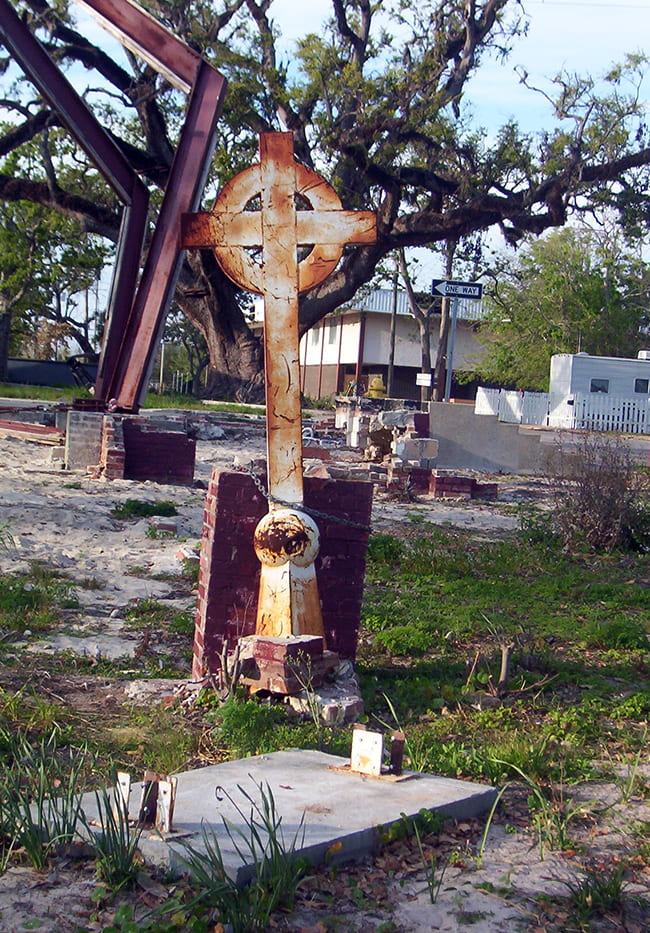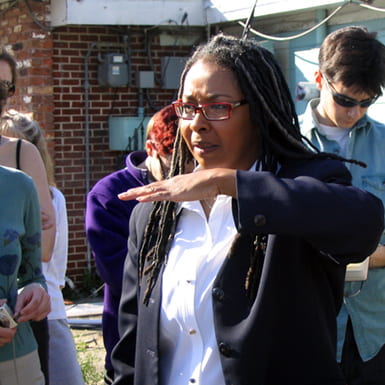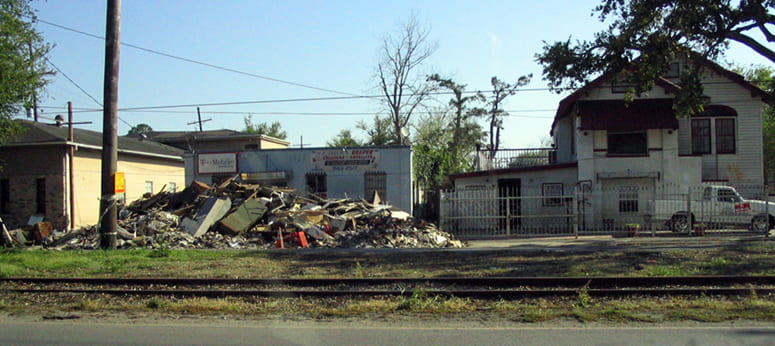
Dialogue
Post-Katrina Theology
New Orleans, 2006. HDS Photo
By Paula Smith
This is not a successful Katrina aid story. The aftermath of Hurricane Katrina was a bewildering blur for pretty much everyone on the Gulf Coast. After 25 years, I returned to my native state, Louisiana, where deep historical divisions along race, class, and political lines still exist above and below the level of consciousness. Yet I hoped that something amazing might come out of all the suffering, that people who would never have sat down in a room together before this disaster might now be willing to do so.
I wanted to make a difference in the lives of people who had been so dramatically displaced and so conveniently forgotten or blamed, especially those living in the FEMA trailer park, known as Renaissance Village, that I was charged with organizing. For seven months I hoped. Reflecting on my experiences 18 months later, however, I mostly feel paralyzed by feelings and memories of distress, anger, and sadness.

Paula Smith with other members of the HDS community on a 2006 service trip to New Orleans. HDS photo
As a theologian, I want to be able to make some kind of theological sense out of my experiences, but I find that adequate language and theological meaning elude me. How does one make theological sense in the twenty-first century of a family of seven (six children and an invalid grandmother) living in a two-bedroom trailer that a middle-class family of four might use for a weekend trip, who get evicted from the only home they know because the mother (banned from the trailer park) sneaks back in to steal the welfare check intended for the children? How does one make theological sense of the “not in my back yard” attitudes held by some local Baton Rouge residents who simultaneously profess that they live by the highest calling of their faith: “Do unto others as you would have them do unto you”? How does one make theological sense of all the black women who approached me in hopes that I was a lawyer so that I could assist them to legally fight various types of abuse they have experienced living in the park? How does one make theological sense of a Baton Rouge restaurant owner who is quoted in the newspaper as saying: “I was told I had to manage the diversity of the terrace bet-ter. There were too many black people”? How does one make theological sense of families, almost two years after the worst natural disaster this country has seen, who still do not know whether they will be al-lowed to rebuild their homes, but who are required to make house payments on their uninhabitable homes?
In late 2005, after Katrina and Rita had struck the Gulf Coast, through a Baton Rouge interfaith-based NGO, I began organizing in two of its local Baptist churches, but my efforts were centered at Renaissance Village FEMA trailer park. It was not clear to anyone at my agency (including me) how organizing would work in Renaissance because of the many dimensions and complexities of issues involved. Four months after the hurricane, I found my-self having to balance my long-term organizing goal—making sure the poor and displaced have a real voice in the rebuilding of devastated areas—with a recurring surge of basic needs to address. Although I was constantly aware that there were residents I was not able to visit because they were elderly, disabled, or fearful of coming forward, many residents did tell me their experiences of wading in the deep infested waters, of screaming for help from the rooftops of their homes, of devastation and the mass exoduses, of the smells and sounds, of the dead bodies floating by. They informed me about the politics of New Orleans as the waters were receding, and recounted the abuse some displaced residents endured from FEMA-contracted security personnel designated to protect them in the trailer park.
During ordinary place-based grassroots organizing, organizers identify and train leaders in the community in various organizing methods under the banner of the institution or congregation. It seemed plausible to me to concentrate efforts and resources on finding ways to minimize the distress the residents were facing, while generating a workable plan for our prospective leaders to identify issues of im-portance to them. However, the primary concerns of the NGO seemed to be tracking the number of “one-to-one” interviews and trying to expand local and regional organizing strength to a national level. This undermined the quality of my interactions and bypassed the main concerns of those residing in the park community.
Still, during the seven months I worked at Renaissance, the residents began trusting me as an organizer, and this led to several small wins. After speaking with over 700 residents, I had identified potential leaders, and together with other residents, they launched a mass petition drive aimed at Renaissance FEMA park officials, calling for immediate action on a variety of items. The first item on the agenda was jobs. The cry of the residents for employment was eventually heard by FEMA Renaissance officials. Together with the Labor Department, FEMA Renaissance Village held a job fair on the park grounds and our resident council committee was approached by the CEO at Renaissance to mobilize the residents to attend. The committee members made flyers and posted them in places visible to the residents (kitchen, laundromat, and mailboxes). They announced the fair at the weekly residents’ council meeting. I and several other council members went from trailer to trailer promoting the job fair. We even managed to get one of the local radio stations to announce the job fair on the day of the event.
The fair was a success and attended by more than 500 park residents; yet the leadership of the NGO continually undermined my efforts to establish relationships and maintain a consistent presence at the park. There was no recognition that the displaced residents needed healing, nor was there recognition that I might need to debrief after listening to their horrific stories. I was not allowed to share resources from the NGO, nor was information easily accessible from the collaborative networks, information that might assist me in developing reform efforts.

New Orleans, 2006. HDS photo
Although I didn’t realize it fully at the time, a significant part of the struggle I encountered was that intolerance is a significant characteristic that defines Baton Rouge. I personally experienced this intolerance because I am black, but also lesbian. Permeated with its own unique assortment of racism, sexism, anti-intellectualism, homophobia, and religious self-righteousness, Baton Rouge is a city that remains racially segregated. The airport cab driver was the first to alert me to the blatant segregation of the city when he said, “The niggers live on this side and the whites live on that side.”
And the obstructions went far beyond race. Unless people live within the bounds of a native, white, heterosexual, conservative Christian lifestyle, they experience intolerance, bigotry, and discrimination. I was stymied at every turn by the attitudes, the “gate-keeping,” and the intolerance of local NGOs, though my only mission was to ease the suffering of those residing in a city swollen to twice its pre-Katrina size, where traffic is a nightmare, schoolteachers and caregivers are working double-shifts, and shelters continue to house thousands. I ended up feeling systematically shut out from my native state because people could not accept and integrate one of their own culturally diverse members who had re-turned home in a time of mass suffering.
Theological questions and reflections have haunted me since returning to the Northeast. What is God’s role in suffering, in the exclusion, intolerance, discrimination, and bigotry experienced by the victims of Katrina? In the aftermath, there were those who spoke definitively about a God who punishes. But who among us actually knows and understands definitively God’s will in a time of suffering? As I have attempted to make theological sense of the suffering that came out of Katrina, I especially found value in a portion from Michael Eric Dyson’s book, Come Hell or High Water: Hurricane Katrina and the Color of Disaster. Dyson employs an aspect of Peter Steinfels’s redistributive theodicy and focuses attention on the link between “dissociating God and evil” and probing “human responsibility and agency.” That is to say: God did not send the storm to punish, but in its aftermath, perhaps God wants us to see the truth of our collective actions, including the massive failure in support systems, and to do something about it.
God’s divine action in human suffering cannot be understood without also examining the relation between our beliefs and faiths, our personal and public moral selves, and the events in our lives. As humans, we are terrified to bring the complexity and uncertainty of these dimensions into full consciousness. Instead, we tend to split God in half with our incomplete and flawed religious beliefs, with our inflated egos, with our own mistaken beliefs about who among us in this family of humankind are worthy. We split God into convenient and “appropriate” categories to justify our failing as humans.
We fear looking directly at the reality that Katrina has illuminated because to see the truth, and then to ignore it, would reveal our selfishness and arrogance. Yet this indicates a widespread theological adolescence. Theological maturity requires critical self-examination and an understanding that God’s divine actions are a mystery. If we could come to terms with who we really are (publicly and privately), what we really believe in (a punishing or a loving God), and the relationship between the two, we might become conscious enough to stop poisoning our communities with our shortcomings and sinful character. In this way, a prophetic faith and practice could lead us to embrace the mystery of God while we truly help to relieve the suffering of those still living in places like Renaissance Village.
Paula Smith, who received an MDiv degree from HDS in 2005, is an activist, educator, and clinician. She works with HDS’s Program in Religion and Secondary Education and does private counseling, consulting, and training in Rhode Island.
Please follow our Commentary Guidelines when engaging in discussion on this site.

